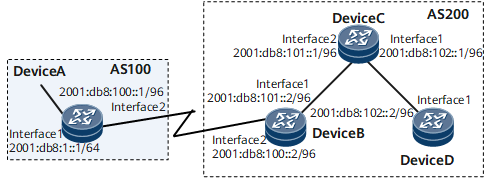Example for Configuring BGP4+ Route Reflection
Configuring BGP4+ RRs simplifies the network configuration because IBGP peers do not need to be fully meshed.
Networking Requirements
In Figure 1, Device B receives an Update packet from its EBGP peer and forwards it to Device C. Device C is an RR and has two clients: Device B and Device D.
Device B and Device D do not need to establish an IBGP connection. After receiving an Update packet from Device B, Device C reflects it to Device D. Similarly, after receiving an Update packet from Device D, Device C reflects it to Device B.
Configuration Roadmap
The configuration roadmap is as follows:
Configure basic BGP4+ functions on each router.
Configure an RR and its clients to establish IBGP connections.
Configure Device C as an RR, and then check its routing information.
Data Preparation
To complete the configuration, you need the following data:
Router IDs of Device A, Device B, Device C, and Device D
AS numbers of Device A, Device B, Device C, and Device D
Procedure
- Configure an IPv6 address for each interface. For configuration details, see Configuration Files in this section.
- Configure basic BGP4+ functions.
# Configure Device A.
[~DeviceA] bgp 100 [*DeviceA-bgp] router-id 1.1.1.1 [*DeviceA-bgp] peer 2001:db8:100::2 as-number 200 [*DeviceA-bgp] ipv6-family unicast [*DeviceA-bgp-af-ipv6] peer 2001:db8:100::2 enable [*DeviceA-bgp-af-ipv6] network 2001:db8:1:: 64 [*DeviceA-bgp-af-ipv6] commit [~DeviceA-bgp-af-ipv6] quit [~DeviceA-bgp] quit
# Configure Device B.
[~DeviceB] bgp 200 [*DeviceB-bgp] router-id 2.2.2.2 [*DeviceB-bgp] peer 2001:db8:100::1 as-number 100 [*DeviceB-bgp] peer 2001:db8:101::1 as-number 200 [*DeviceB-bgp] ipv6-family unicast [*DeviceB-bgp-af-ipv6] peer 2001:db8:100::1 enable [*DeviceB-bgp-af-ipv6] peer 2001:db8:101::1 enable [*DeviceB-bgp-af-ipv6] peer 2001:db8:101::1 next-hop-local [*DeviceB-bgp-af-ipv6] commit [~DeviceB-bgp-af-ipv6] quit [~DeviceB-bgp] quit
# Configure Device C.
[~DeviceC] bgp 200 [*DeviceC-bgp] router-id 3.3.3.3 [*DeviceC-bgp] peer 2001:db8:101::2 as-number 200 [*DeviceC-bgp] peer 2001:db8:102::2 as-number 200 [*DeviceC-bgp] ipv6-family unicast [*DeviceC-bgp-af-ipv6] peer 2001:db8:101::2 enable [*DeviceC-bgp-af-ipv6] peer 2001:db8:102::2 enable [*DeviceC-bgp-af-ipv6] network 2001:db8:101:: 96 [*DeviceC-bgp-af-ipv6] network 2001:db8:102:: 96 [*DeviceC-bgp-af-ipv6] commit [~DeviceC-bgp-af-ipv6] quit [~DeviceC-bgp] quit
# Configure Device D.
[~DeviceD] bgp 200 [*DeviceD-bgp] router-id 4.4.4.4 [*DeviceD-bgp] peer 2001:db8:102::1 as-number 200 [*DeviceD-bgp] ipv6-family unicast [*DeviceD-bgp-af-ipv6] peer 2001:db8:102::1 enable [*DeviceD-bgp-af-ipv6] commit [~DeviceD-bgp-af-ipv6] quit [~DeviceD-bgp] quit
- Configure a BGP4+ RR.
# Configure Device C as an RR, with Device B and Device D as its clients.
[~DeviceC-bgp] ipv6-family unicast [*DeviceC-bgp-af-ipv6] peer 2001:db8:101::2 reflect-client [*DeviceC-bgp-af-ipv6] peer 2001:db8:102::2 reflect-client [*DeviceC-bgp-af-ipv6] commit
- Verify the configuration.
# Check the routing table of Device B.
[~DeviceB] display bgp ipv6 routing-table BGP Local router ID is 2.2.2.2 Status codes: * - valid, > - best, d - damped, x - best external, a - add path, h - history, i - internal, s - suppressed, S - Stale Origin : i - IGP, e - EGP, ? - incomplete RPKI validation codes: V - valid, I - invalid, N - not-found Total Number of Routes: 3 *> Network : 2001:db8:1:: PrefixLen : 64 NextHop : 2001:db8:100::1 LocPrf : MED : 0 PrefVal : 0 Label : Path/Ogn : 100i i Network : 2001:db8:101:: PrefixLen : 96 NextHop : 2001:db8:101::1 LocPrf : 100 MED : 0 PrefVal : 0 Label : Path/Ogn : i *>i Network : 2001:db8:102:: PrefixLen : 96 NextHop : 2001:db8:101::1 LocPrf : 100 MED : 0 PrefVal : 0 Label : Path/Ogn : i
# Display the routing table of Device D.
[~DeviceD] display bgp ipv6 routing-table BGP Local router ID is 4.4.4.4 Status codes: * - valid, > - best, d - damped, x - best external, a - add path, h - history, i - internal, s - suppressed, S - Stale Origin : i - IGP, e - EGP, ? - incomplete RPKI validation codes: V - valid, I - invalid, N - not-found Total Number of Routes: 3 *>i Network : 2001:db8:1:: PrefixLen : 64 NextHop : 2001:db8:101::2 LocPrf : 100 MED : 0 PrefVal : 0 Label : Path/Ogn : 100i *>i Network : 2001:db8:101:: PrefixLen : 96 NextHop : 2001:db8:102::1 LocPrf : 100 MED : 0 PrefVal : 0 Label : Path/Ogn : i i Network : 2001:db8:102:: PrefixLen : 96 NextHop : 2001:db8:102::1 LocPrf : 100 MED : 0 PrefVal : 0 Label : Path/Ogn : i
The preceding command output shows that Device D has learned from Device C the routes advertised by Device A.
Configuration Files
Device A configuration file
# sysname DeviceA # interface GigabitEthernet0/1/0 undo shutdown ipv6 enable ipv6 address 2001:db8:1::1/64 # interface GigabitEthernet0/1/8 undo shutdown ipv6 enable ipv6 address 2001:db8:100::1/96 # bgp 100 router-id 1.1.1.1 peer 2001:db8:100::2 as-number 200 # ipv6-family unicast undo synchronization network 2001:db8:1:: 64 peer 2001:db8:100::2 enable # return
Configuration file of Device B
# sysname DeviceB # interface GigabitEthernet0/1/0 undo shutdown ipv6 enable ipv6 address 2001:db8:101::2/96 # interface GigabitEthernet0/1/8 undo shutdown ipv6 enable ipv6 address 2001:db8:100::2/96 # bgp 200 router-id 2.2.2.2 peer 2001:db8:100::1 as-number 100 peer 2001:db8:101::1 as-number 200 # ipv6-family unicast undo synchronization peer 2001:db8:100::1 enable peer 2001:db8:101::1 enable peer 2001:db8:101::1 next-hop-local # return
Device C configuration file
# sysname DeviceC # interface GigabitEthernet0/1/0 undo shutdown ipv6 enable ipv6 address 2001:db8:102::1/96 # interface GigabitEthernet0/1/8 undo shutdown ipv6 enable ipv6 address 2001:db8:101::1/96 # bgp 200 router-id 3.3.3.3 peer 2001:db8:101::2 as-number 200 peer 2001:db8:102::2 as-number 200 # ipv6-family unicast undo synchronization network 2001:db8:101:: 96 network 2001:db8:102:: 96 peer 2001:db8:101::2 enable peer 2001:db8:101::2 reflect-client peer 2001:db8:102::2 enable peer 2001:db8:102::2 reflect-client # return
Device D configuration file
# sysname DeviceD # interface GigabitEthernet0/1/0 undo shutdown ipv6 enable ipv6 address 2001:db8:102::2/96 # bgp 200 router-id 4.4.4.4 peer 2001:db8:102::1 as-number 200 # ipv4-family unicast undo synchronization # ipv6-family unicast undo synchronization peer 2001:db8:102::1 enable # return

